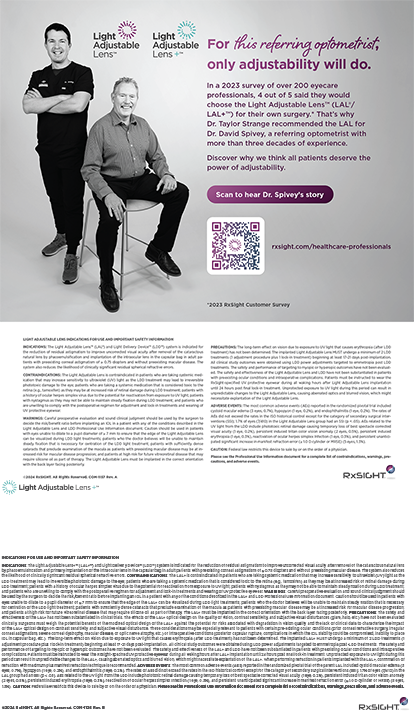Case Presentation
A 58-year-old white female with contact lens intolerance was referred for evaluation. She had 20/30 visual acuity in the right eye, and 20/20 visual acuity in the left eye. Her refraction as of January 1999 was -6.25 +3.25 x 094 in the right eye, and -3.5 +5.0 x 085 in the left eye. I hypothesized that the etiology of her decreased acuity in the right eye was possibly due to meridional amblyopia, caused by a high degree of astigmatism. Other than the astigmatism, her corneas were normal. There was a trace to 1+ nuclear sclerosis in each eye. The remainder of the retinal and ocular examinations was unremarkable.
1. Prescribe spectacles?
2. Prescribe Bitoric rigid contact lenses?
3. Perform LASIK?
4. Perform Clear lens replacement?
The patient elected to proceed with bitoric contact lenses for each eye. She found the bitoric lenses performed better then her previous lenses, although she still needed reading glasses. When I saw this patient again in January 2000, her overall refraction had changed only slightly, but her visual acuities had decreased one line in the right eye and two lines in the left eye. Nuclear sclerosis had increased in both eyes. Nerve and retinal examinations remained normal. However, Potential Acuity Meter readings were 20/25+ in the right eye, and 20/20- in the left. At this point it was clear that lenticular etiology was the cause of decreased vision in both eyes.
Which would you choose?1. Wait for her to qualify as a cataract patient, or perform a clear lens extraction?
2. What type of lens would you place in this patient?
3. How would you manage her astigmatism?
Surgical Course
The patient did not want to wait until cataract qualification would have been justified by her insurance, so we proceeded with clear lens extraction. During our work-up, we tried to determine whether she could tolerate any amount of monovision, but she could not. We therefore targeted plano for each eye.
First, I wanted to find out how much of the astigmatism I could correct with the toric lens alone, so I did not use a limbal relaxing incision (LRI) in the right eye. The resulting refraction was -1 +1.75 X 080, which was a perfect refraction for performing LRIs. Next, I retreated the right eye with dual LRIs, and the result was plano +0.75 X 041 for 20/20- acuity at 1 year postoperatively. The left eye received a concurrent toric plate IOL, and dual LRIs were performed. The resulting refraction was -0.50 +0.75 X 017 for 20/20 visual acuity at 1 year postoperatively. The patient is now functioning with reading glasses for up-close work, and does not require any help for distance vision. One year postoperatively, the patient was 20/25 OD and 20/20 OS uncorrected for distance.
For the surgery, I selected a Toric™ intraocular lens (StAAr Surgical, Monrovia, CA) with a 3.5 D toric correction. I assumed that that lens would produce roughly 2 to 2.5 units of astigmatic correction in the left eye. With the LRIs, we reduced the corneal astigmatism by 3.25 D from a preoperative value of 4.75 D, to 1.50 D postoperatively.
John F. Doane, MD, FACS, is in private practice with Discover Vision Centers in Kansas City, Missouri, and is Clinical Assistant Professor of the Department of Ophthalmology, Kansas University Medical Center. Dr. Doane may be reached at (816) 350-4539; jdoane@discovervision.com

